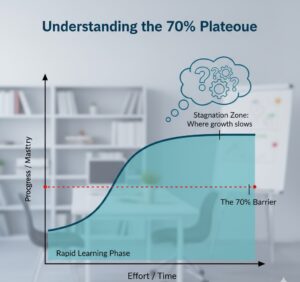In many modern workplaces, Gallup research shows about 70% of employees admit they are not fully committed to their best work. However, this phenomenon is broader than corporate offices – it can happen in any area of life. Typically, people settle for “good enough” effort due to fear, habit, or lack of engagement. Consequently, tasks drag on and opportunities are missed. In fact, a fixed mindset – believing abilities are unchangeable – triggers fear of failure and reduced motivation.
Understanding the 70% Plateau

Often, a key cause of limited effort is simple caution. Likewise, many of us worry that giving 100% risks failure or burnout. Importantly, experts warn that overworking reduces results: Stanford found productivity per hour drops sharply after about 50 hours per week. Meanwhile, stagnation sets in when routine seems adequate. Moreover, lack of challenge can dull our drive.
Engagement and Leadership
Additionally, leadership and support influence effort levels. Gallup research shows that about 70% of an employee’s motivation is driven by their manager. When managers fail to engage or recognize good work, employees often coast at 70%. Conversely, clear goals and feedback inspire people to stretch further. Thus, environment and mindset together tend to set a 70% effort limit.
The 100% Difference: Results and Rewards
By contrast, when people give their full effort, big changes happen. Indeed, motivated, engaged individuals consistently deliver more. For example, highly motivated employees are about 30% more productive, have higher sales, and stay longer on the jobweforum.org. Likewise, engaged workforces achieve about 23% higher profits and 18% higher productivitycerkl.com. In practice, going from 70% to 100% often brings greater satisfaction and growth. Consequently, tasks get done faster and team energy improves.
Importantly, committing fully fosters a growth mindset: setbacks become learning opportunities instead of proof of limits. As a result, such employees innovate more and stay engaged. In fact, high-performing teams often say commitment and teamwork fuel their energy, not burnout. Thus, reaching 100% can revitalize motivation and performance.
Strategies to Give 100%
To bridge the gap between 70% and full potential, consider these steps:
-
Set clear goals and priorities: Identify the most important tasks and focus on them fully. This sharp focus ensures your energy goes where it matters.
-
Cultivate a growth mindset: Remind yourself that skills grow with effort. View challenges as chances to learn instead of threats to avoid.
-
Seek feedback and support: Engage mentors or colleagues who encourage you. Constructive feedback can challenge complacency and push performance upward.
-
Maintain health and balance: Keep energy high through proper sleep, exercise, and breaks. Sustainable effort is easier with a healthy routine.
-
Celebrate progress: Acknowledge even small wins to stay motivated. Tracking improvements reinforces the payoff of full effort.
Additionally, supportive leadership makes a difference: rewarding effort, giving clear direction, and valuing innovation encourage people to try harder. This way, moving from 70% to 100% becomes a shared goal rather than a personal burden.
Finally, improving effort is a gradual process. Each extra bit of commitment adds up, boosting both personal success and team results. Therefore, by shifting mindset, setting smart targets, and focusing energy, most people can gradually move closer to 100% of their potential.









